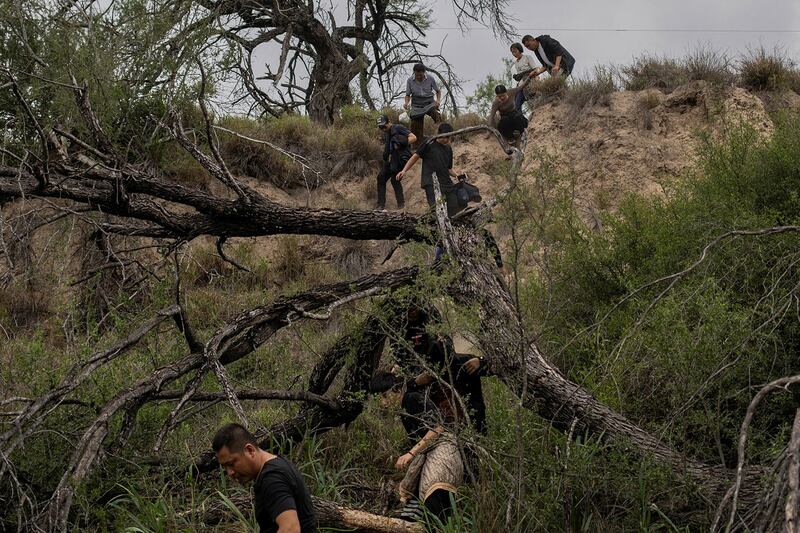China has called on Mexico to "speed up" its investigation of the deaths of eight of its nationals in a boat capsize, highlighting the dangers faced by tens of thousands of Chinese people who have traveled to the Mexico-U.S. border to seek political asylum in recent years.
"The Chinese Embassy in Mexico ... has requested the Mexican side to speed up the investigation into the incident and sent a working group to the site of the incident," Chinese foreign ministry spokesperson Wang Wenbin told a regular news briefing in Beijing on Tuesday, adding that China is paying "close attention" to the incident.
Eight Chinese nationals were found dead following a "migration situation" off the coast of the Isthmus of Tehuantepec, the Attorney General's Office of the Mexican state of Oaxaca said in a statement on its website dated March 30.
"The Oaxaca Prosecutor's Office ... established that they were people from China, seven women and one man," the statement said, quoting a survivor as saying that the victims had been traveling aboard a boat from Tapachula in Chiapas state on March 29, when it overturned.
The eight bodies were found near Playa Vicente beach on the isthmus, it said, adding that local authorities are working with officials from the Chinese embassy to identify the victims.
Wang said the embassy "is in close touch with the Mexican side to further verify the information of the deceased and provide assistance to the surviving Chinese national."
In the 12 months to Sept. 30, 2023, more than 24,000 Chinese nationals followed one of several arduous and sometimes dangerous people-smuggling routes through South and Central America to cross the border from Mexico and apply for political asylum in the United States.
The routes sometimes include a hazardous trip across the sea in a small boat.
"I’ll never forget it as long as I live," migrant Li Kai told RFA Mandarin in a recent interview about the sea passage he took with his family. "It was very dangerous."
"The boat was small, made of fiberglass, which made it especially vulnerable to the unpredictable sea conditions and weather of the Caribbean," Li said. "I felt an overwhelming sense of guilt for putting my kids in such danger because I had gotten into trouble in China."
Li's account also suggested that the Oaxaca deaths weren't the first among Chinese migrants making the journey to the United States.
"I heard that one of these boats had capsized and people had drowned," Li said in an interview recorded weeks before the March 29 tragedy.
'Run' movement
Known in China as the "run" movement, using a Chinese character that sounds similar to the English word "run," the migration wave has its roots in widespread dissatisfaction with political totalitarianism and economic stagnation under ruling Chinese Communist Party leader Xi Jinping.
It took off following the relaxation of the grueling lockdowns, mass incarceration in quarantine camps and compulsory testing of the three-year-long zero-COVID policy in December 2022.

A former migrant who took the route through Mexico, known in Chinese as "walking the line," said the route is known for its hazards.
"It has always been dangerous," he said, likening the wave of migration from China to the fleeing of animals before a major earthquake.
"Before a major earthquake, there are always signs, like all of the animals running away," he said, suggesting China will endure a future of economic and political upheaval.
"Right now, a big earthquake is coming, that's the only way I can explain it."
Likely evasion route
California-based China Democracy Party activist Jie Lijian, who regularly assists Chinese asylum-seekers after they arrive in the United States, said the latest accident wasn't on a well-known "line" into the United States, and that the route had likely been taken to evade maritime patrols on better-known routes.
"They will take routes across wider stretches of sea with bigger waves as a shortcut for the land route," Jie told RFA in a recent interview.
"The sea may be dangerous and unpredictable, but if you go that way, you can avoid a lot of border inspections, the threat of deportation, high fees and private robbery gangs [who prey on migrants]," Jie said.

The numbers of Chinese seeking the route to the U.S. border have likely been boosted by promotions from people smugglers who extol the benefits of life in the United States, he said.
Last year, the video platform Tik Tok saw the emergence of hashtags and videos teaching Chinese citizens fleeing the country how to navigate through Latin America, as well as helping with the bureaucratic intricacies of getting settled in the United States while making a political asylum claim.
Translated by Luisetta Mudie .
